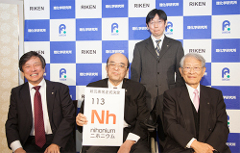Nov. 30, 2016
Element 113 has an official name! The name is nihonium, and the chemical symbol Nh
 Group Director Kosuke Morita (second from left) at press conference on December 1
Group Director Kosuke Morita (second from left) at press conference on December 1
The International Union of Pure and Applied Chemistry (IUPAC) has officially approved the name (nihonium) and chemical symbol (Nh) proposed earlier this year for element 113 by a research group led by Group Director Kosuke Morita of the RIKEN Nishina Center for Accelerator-Based Science Research Group for Superheavy Element.
Morita’s team began their work to discover new super heavy elements in September 2003, using RIKEN's heavy ion linear accelerator (RILAC), which forms part of RIKEN’s heavy ion beam accelerator facility, the RI Beam Factory. In July 2004 the group successfully synthesized element 113 for the first time, and was successful again in April 2005 and August 2012. On December 31, 2015, the group’s discovery was officially recognized, and IUPAC awarded them naming rights to the new element. In response, on March 18 the group gave IUPAC a proposal for the name nihonium and the chemical symbol Nh. A five-month period of public comment began on June 8, and following its conclusion, on November 30 IUPAC announced that the names had been officially approved.
Morita released the following comment:
“I am very pleased that the name and symbol of the new element 113, ‘nihonium’ and ‘Nh’ which our group proposed to IUPAC, were formally acknowledged. Following this decision, the first element discovered in Japan and Asia will earn a permanent seat on the periodic table, an intellectual legacy that will be passed down to the future generations for the benefit of humankind. We feel truly honored and wish to express our deepest gratitude to all those who have given us support over the years.
Basic science has produced many breakthroughs which have tremendously benefited mankind in ways unthinkable at the time of the discoveries. It is rare however, for basic science to directly impact people’s everyday life. We are ever so grateful to the Japanese people, and our research center, the relevant government ministries and agencies, for their continuous support for basic scientific research which takes time and requires a long-term perspective.”
